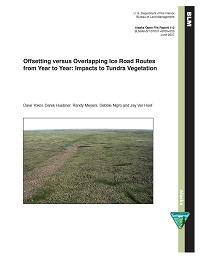Offsetting versus Overlapping Ice Road Routes from Year-to-Year: Impacts to Tundra Vegetation. Fairbanks District Office

In the Record of Decision for the Northeast National Petroleum Reserve – Alaska Integrated Activity Plan (1998), the Bureau of Land Management stipulated that the location of ice roads be offset from year to year. The rationale for this requirement was based on the assumption that it is environmentally preferable to spread the impact over a greater area of tundra because in that way the tundra vegetation will recover more quickly, i.e., a less severe impact over a greater area is preferable to a more severe impact over a smaller area. This study was intended to test a part of that assumption: additive impacts occur to tundra vegetation with subsequent years of ice road construction.
We established transects across ice road paths with four plots per transect: control (outside the road boundaries) and three treatments (2001 road only, overlap area of 2001 and 2002 roads, and 2002 road only). In each of three summers (2002–2004), we measured depth of thaw, proportion of tussocks damaged, and percent ground cover by eight vegetation cover types to see if greater impacts occurred in the overlap-road plots than in the single-year road plots.
No statistically significant differences in depth of thaw were found among control and treatment plots or between single-year plots and overlap plots. The only significant result among the thaw data was a “year effect”: the thaw depths for all treatments became deeper with each successive year.
The data for proportion of tussocks damaged showed significant overall differences among the control and treatments, due mostly to the marked difference between the control by itself and the three road treatments combined. More importantly, the overlap treatment displayed a marginally greater level of damage than the two single-year treatments. However, a significant year effect due to a decrease in damaged tussocks from one year to the next suggested the resilience of tussocks to some types of damage.
The percent of ground cover by eight vegetation cover types showed no significant difference between the overlap-road plots and the single-year road plots when data from three years were combined, but did display a significant additive effect in the overlap-road plots for one year (2003) when the three years were analyzed separately.
Data from this three-year study provided only minimal evidence of additive impacts from building ice roads over the same path in two subsequent years. Given the observed recovery of the tundra during the three years of study, it is doubtful that any significant environmental benefit would be gained by requiring that all ice roads be completely offset from paths of previous years. A more appropriate mitigation would be to require that ice road routes follow the wetter habitats to the greatest extent possible without significantly increasing their length.
